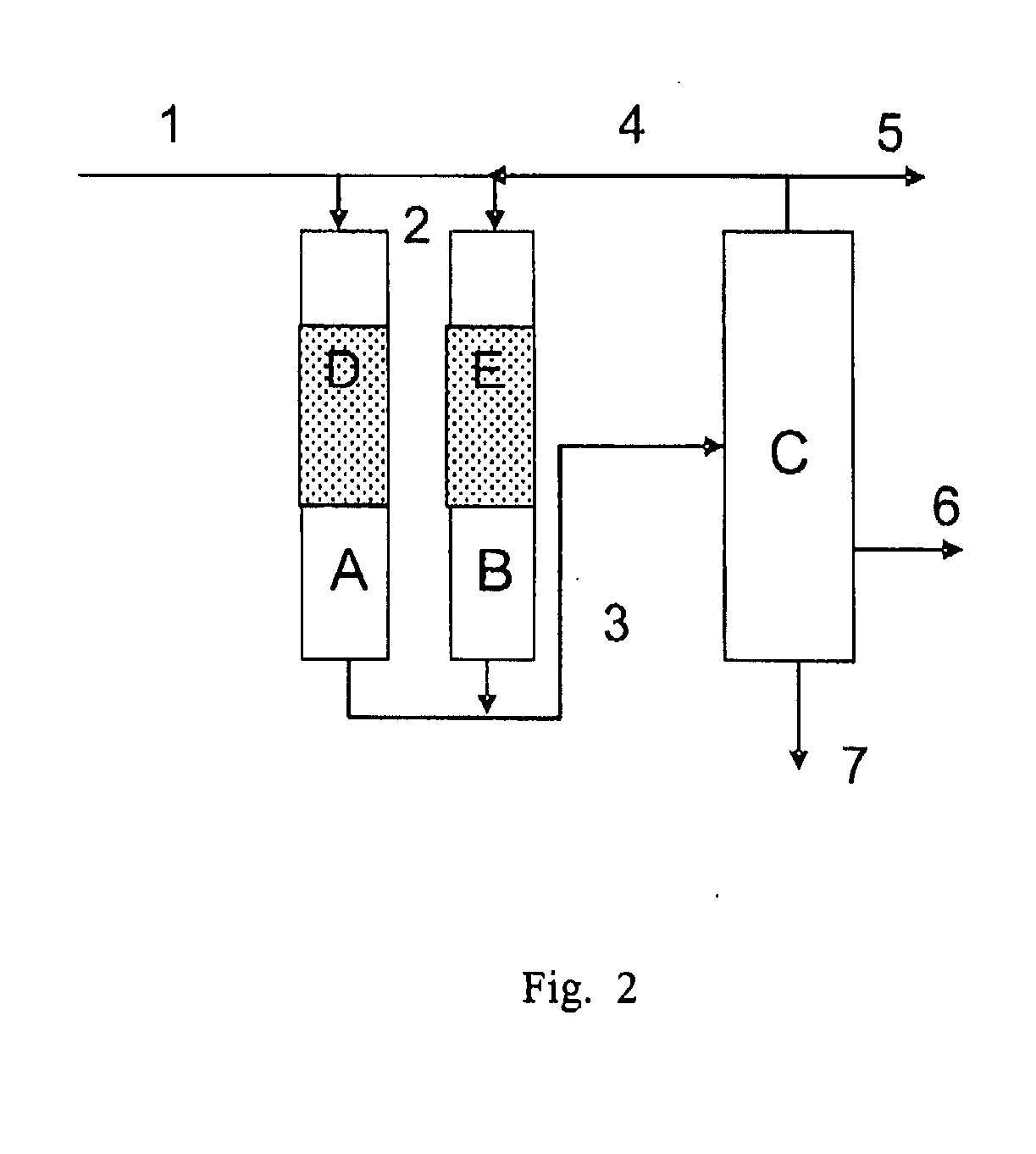Process for the manufacture of polyolefins
a technology for polyolefins and polyolefins, applied in the direction of sustainable manufacturing/processing, hydrocarbon by addition and hydrogenation, separation processes, etc., can solve the problems of cracking and isomerization reactions of feedstock olefins, and formation of heavier oligomers
- Summary
- Abstract
- Description
- Claims
- Application Information
AI Technical Summary
Benefits of technology
Problems solved by technology
Method used
Image
Examples
example 1
Comparative Example
Dimerization of Olefins in a Batch Reactor
[0062] Dimerization process was performed in a batch reactor using 1-hexadecene (Neodene 16®). The process temperature was 200° C., the reactor pressure being 20 bar. The amount of the feedstock was 50 g, and that of the catalyst 2 g. The total reaction time was 24 hours. Commercially available Y zeolite (TOSOH Co.), beta-zeolites (TOSOH Co.) and a mesoporous material MCM-41 (produced according to a method disclosed in Catalysis Letters 36 (1996) 103) were used as catalysts. Total C16 conversion (=conversion of C16 hydrocarbons to give products having a carbon numer of ≠16) and selectivities for different reaction products are shown in the table 2 below.
TABLE 2Dimerization of 1-hexadecene in a batch reactorCatalystBetaBetaYH-MCM-41Total C16 conversion / (%)48.376.976.072.7Selectivity / (%)light products (18.114.30.83.2C16-C3224.119.80.40.0dimers47.852.283.462.6trimers8.810.715.030.4heavier (>C48)1.22.91.23.8
[0063] Dimeriza...
example 2
Dimerization in a System Corresponding to a Catalytic Distillation Apparatus, Comprising Dimerization in a Flow Reactor and Distillation
a) Dimerization in a Flow Reactor
[0064] 1-Hexadecene (Neodene 16®) was introduced at a rate of 10 g / h into a flow reactor (1 bar (a)). The flow reactor was packed with 5 g of aluminium silicate catalyst (Nikki Chemical Co. Ltd) with an aluminium content of 13% by weight, the number of acid sites of 120 μmol / g, and mesoporous surface area >300 m2 / g, diluted with silicon carbide (V(catalyst):V (SiC)=1:3), followed by the dimerization reaction at a temperature of 120° C. in the reactor. The dimerization product was collected into a product container. Results of the dimerization, that is, total C16 conversion and selectivities for different reaction products are shown in the table 3 below.
TABLE 3Dimerization of 1-hexadecene in a flow reactor (120° C.)Time (TOS) / h62448Total C16 conversion / (%)52.646.641.7Selectivity / (%)light products (0.00.00.0C16-C3...
example 3
Hydrogenation of the Dimerized Products, and Properties of the Produced Base Oil Product
[0069] The dimerized product of example 2, separated by distillation, and the bottom product of the distillation were hydrogenated as separate batches in a batch reactor using a heterogeneous nickel catalyst. In the hydrogenation, the reaction time was 2 hours, the temperature was 200° C., and the pressure was 50 bar. The properties of the hydrogenated dimer and the bottom product are presented in table 6 below.
TABLE 6Hydrogenated dimer and hydrogenated bottom productHydrogenatedHydrogenatedProperty / unitMethoddimer productbottom productLighter than the dimer / ASTM D28870.20.0% by weightDimer / % by weightASTM D288799.649.9Trimer / % by weightASTM D28870.239.7Tetramer and heavier / ASTM D28870.010.4% by weightViscosity at 100° C. / ASTM D 4454.2416.916cStViscosity at 40° C. / cStASTM D 44518.2736.85Viscocity index (VI)ASTM D 2270142150Noac evaporation loss / CECL-40-93-B7.9not determined% by weightPour poin...
PUM
| Property | Measurement | Unit |
|---|---|---|
| pressure | aaaaa | aaaaa |
| pressure | aaaaa | aaaaa |
| pressure | aaaaa | aaaaa |
Abstract
Description
Claims
Application Information
 Login to View More
Login to View More - R&D
- Intellectual Property
- Life Sciences
- Materials
- Tech Scout
- Unparalleled Data Quality
- Higher Quality Content
- 60% Fewer Hallucinations
Browse by: Latest US Patents, China's latest patents, Technical Efficacy Thesaurus, Application Domain, Technology Topic, Popular Technical Reports.
© 2025 PatSnap. All rights reserved.Legal|Privacy policy|Modern Slavery Act Transparency Statement|Sitemap|About US| Contact US: help@patsnap.com



